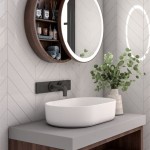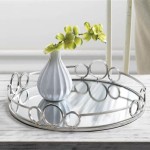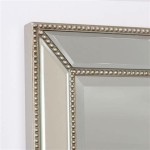```html
How To Hang A Wall Mirror With Wire
Hanging a wall mirror can significantly enhance the aesthetics of a room, adding light and creating a sense of spaciousness. Mirrors with pre-installed wire hangers offer a relatively straightforward installation process. This article provides a comprehensive guide on how to hang a wall mirror with wire, ensuring a secure and visually appealing result.
Assessing the Mirror and Wall
Before commencing the hanging process, a thorough assessment of both the mirror and the wall is crucial. Begin by examining the mirror's weight. This information is often found on the packaging or can be estimated based on the mirror's dimensions and thickness. Understanding the mirror's weight is paramount for selecting the appropriate hanging hardware. Overestimating the weight capacity of the hardware is always preferable to underestimating, as this directly impacts the mirror's safety and stability.
Next, carefully inspect the wire hanger on the back of the mirror. Ensure the wire is securely fastened to the D-rings or mounting brackets. Check for any signs of rust, fraying, or weakness in the wire itself. If the wire appears compromised, it should be replaced with a new, appropriately rated wire. The length of the wire also influences the final hanging position; a longer wire will cause the mirror to hang lower than a shorter wire.
The wall surface also requires careful evaluation. Determine the wall type: drywall, plaster, or solid wood. Drywall is the most common type and requires specialized anchors to support the weight of the mirror. Plaster walls can be more brittle and may require extra care to avoid cracking. Solid wood walls offer the strongest support and may only require screws directly into the wood studs. Identifying the location of wall studs is critical for securely hanging heavier mirrors. Stud finders are readily available and can accurately locate these structural supports behind the wall surface.
Selecting the Appropriate Hardware
Choosing the right hardware is paramount for a successful and secure mirror hanging. The weight of the mirror and the wall type are the primary factors influencing hardware selection. For drywall, various anchor types are available, including drywall anchors, toggle bolts, and self-drilling anchors. Drywall anchors are suitable for lighter mirrors, typically those weighing under 10 pounds. Toggle bolts provide superior holding power and are recommended for heavier mirrors, particularly those exceeding 20 pounds. Self-drilling anchors offer a convenient option for smaller mirrors, as they eliminate the need for pre-drilling a pilot hole.
For plaster walls, using plaster screws or picture-hanging hooks designed for plaster is recommended. These hooks often have small nails that are hammered into the plaster at an angle, providing a secure hold. For solid wood walls, screws driven directly into the studs provide the strongest and most reliable support. The length of the screw should be sufficient to penetrate deeply into the stud, typically at least 1.5 inches. Avoid using nails in solid wood, as they are less secure than screws and can potentially damage the wood.
In addition to wall anchors, consider the type of hook or nail used to hang the mirror's wire. Ensure the hook or nail is strong enough to support the weight of the mirror and has a wide enough opening to accommodate the wire. Picture-hanging hooks are specifically designed for this purpose and are available in various sizes and weight capacities. When using nails, select a heavy-duty nail with a large head to prevent the wire from slipping off.
The Hanging Process: A Step-by-Step Guide
Once the appropriate hardware has been selected, the actual hanging process can begin. This process requires precision and attention to detail to ensure the mirror is hung securely and levelly.
Step 1: Mark the Desired Location: Begin by determining the desired location for the mirror on the wall. Use a measuring tape and level to ensure the mirror will be hung at the correct height and orientation. Lightly mark the top center point of the mirror's intended position on the wall. This mark serves as a reference point for determining the placement of the hanging hardware.
Step 2: Measure the Wire Distance: With the mirror placed face down on a protected surface, measure the distance between the top of the mirror frame and the highest point of the stretched wire. This measurement represents the distance the hanging hardware needs to be placed below the marked center point on the wall. Accurately measuring this distance is crucial for achieving the desired hanging height.
Step 3: Install the Hanging Hardware: Based on the wall type and the selected hardware, install the anchor, screw, or hook at the calculated position. For drywall anchors, pre-drill a pilot hole if required and insert the anchor according to the manufacturer's instructions. For toggle bolts, drill a larger hole through the wall and insert the toggle bolt, ensuring the wings expand properly behind the wall. For screws in wood studs, drive the screw directly into the stud using a screwdriver or drill. Ensure the screw or hook is securely fastened and can support the weight of the mirror.
Step 4: Hang the Mirror: Carefully lift the mirror and position the wire over the installed hook or screw. Ensure the wire is securely seated on the hook or screw and that the mirror is hanging freely. Gently release the mirror and observe its stability. If the mirror wobbles or appears unstable, immediately remove it and re-evaluate the hardware or installation. A stable mirror is crucial for safety and preventing accidental falls.
Step 5: Check for Level: Use a level to check the mirror's horizontal orientation. If the mirror is not level, gently adjust its position by slightly shifting the wire on the hook or screw. Minor adjustments can often be made without removing the mirror entirely. For larger adjustments, the hardware may need to be repositioned. Continue checking for level until the mirror is perfectly aligned.
Step 6: Secure the Mirror (Optional): For added security, particularly in high-traffic areas, consider using mirror hanging clips or brackets to further stabilize the mirror. These clips attach to the bottom of the mirror frame and are screwed into the wall, preventing the mirror from tilting or being accidentally knocked off the wall. These are especially useful for larger and heavier mirrors.
Step 7: Final Inspection: Once the mirror is hanging level and securely, conduct a final inspection. Check the wire hanger for any signs of stress or slippage. Ensure the wall anchor or screw is firmly embedded in the wall and can adequately support the weight of the mirror. If any issues are detected, address them immediately to prevent potential accidents.
By following these steps, individuals can successfully and safely hang a wall mirror with wire, enhancing the aesthetic appeal of their living space. Always err on the side of caution when selecting hardware and ensure a secure installation to prevent accidents and protect the mirror from damage.
```
How To Hang A Mirror With Wire Pictures Wikihow

How To Adjust A Mirror Art Or Picture Hanging Wire
How To Hang A 100 Pound Mirror On Drywall Quora

How To Hang A Mirror With Wire Pictures Wikihow

How To Hang A Heavy Mirror With Pictures Wikihow

How To Hang A Heavy Mirror The Home Depot

How To Adjust A Mirror Art Or Picture Hanging Wire

How To Hang A Mirror With Wire Pictures Wikihow

How To Install Wire On Back Of Mirror

How To Hang A Heavy Mirror








